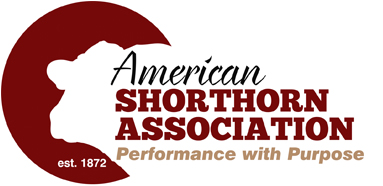The Shorthorn breed originated on the Northeastern coast of England in the counties of Northcumberland, Durham, York and Lincoln. The first real development of the breed occurred in the valley of the Tees River about 1600. The large framed cattle that inhabited this fertile valley became known as Teeswater cattle.
The breed later spread to Scotland and then to America in 1783. When first brought to Virginia, the breed had attained the name Durham. It was the first improved breed to be imported into the new world and the qualities the animal possessed made it in great demand and its influence spread rapidly across America.
Shorthorns were popular with America’s early settlers. They valued this breed for meat and milk and found Shorthorns a willing power for the wagon and plow. The breed followed pioneer wagons across the Great Plains and into the far West. By 1854, Midwestern farmers had begun direct importations from Scotland, concentrating their efforts on Shorthorns strictly for beef production.
Even in its early history, the breed was recognized because of its ability to adapt. It could be easily bred with the Spanish breed, Longhorns, brought in earlier by conquistadors. These early animals fit neatly in the time period to meet demand and needs during the early development of the beef cattle industry.
Although Shorthorns came first, in the 1870’s breeders discovered ‘natural hornless’ cattle occurring from time-to-time in horned herds. Thus, Polled Shorthorns were discovered and were the first major beef breed to be developed in the United States, having gained its origin in 1881 in Minnesota. Polled Shorthorns possess the same qualities for adaptability, mothering ability, reproductive performance, good disposition, feed conversion, longevity and popularity as their horned counterparts.
In 1822, the first herd book record was established by Shorthorn breeders called the Coates Herd Book. In 1846 The American Shorthorn Herd Book was the first to be published in this country for any breed, with the formation of the American Shorthorn Association (ASA) following 26 years later in 1872. Breeders from nine states formulated the organization, wishing to provide a service for its members and a way to record ancestry through the registration of Shorthorns. The ASA is one of the oldest American breed organizations in existence today.
Today the ASA has an Appendix Registry (AR) program, which includes ShorthornPlus and Durham Red registered cattle, which has been ongoing since 1973 with the intent to promote and verify Shorthorn influence in commercial production. This program has strengthened the Shorthorn influence by increasing numbers and providing additional germ plasm through the use of related and non-related breeds. The ASA is the only British breed with an ongoing Appendix program documenting the influence of related and non-related breeds in the breed registry.
The ASA records approximately 15,000 animals each year. More than 20,000 head are maintained in the association’s whole herd registry. The current membership is in more than 6,000 combined junior and senior members.
Current statistics for the ASA as of Fall 2018
- Registrations are up to 14,832, with nearly 7,978 transfers
- ShorthornPlus = 23.4% of total
- WHR enrollment: 22,000 head
- Top 5 states
1. Iowa
2. Illinois
3. Indiana
4. Ohio
5. Kansas
Past Executive Secretaries
- Lewis P. Muir 1882-1883
- James H. Pickrell 1884-1900
- John W. Groves 1901-1912
- Roy G. Groves 1913-1914
- Frank W. Harding 1915-1919
- K. Groves 1920-1930
- Frank W. Harding 1931-1938
- J. Gramlick 1939-1942
- Clint K. Tomson 1943-1951
- Allan C. Atlason 1952-1957
- Kenneth Fulk 1958-1960
- D. “Pete” Swaffar 1961-1979
- James W. Shirley 1980-1982
- Roger E. Hunsley 1983-2002
- Ron Bolze 2003-2006
- Greg Ruehle 2007-2008
- Bert Moore 2008-2013
- Montie D. Soules 2013-Present





